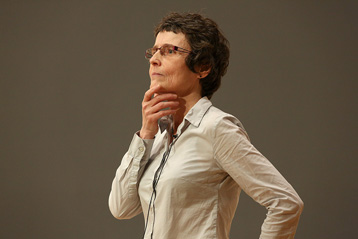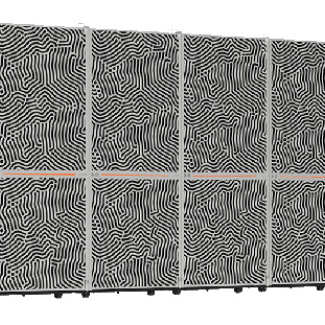
Mathematician Claire Voisin awarded the CNRS 2016 gold medal
The mathematician Claire Voisin is the laureate of the CNRS 2016 gold medal, France's highest scientific distinction. This award, which will be handed out on 14 December, 2016, in Paris, honors her major contributions to complex algebraic geometry. Recognized for her thorough knowledge in this field and for the originality and diversity of her research, she has received numerous prizes. A genuine French ambassador in mathematics, she has exceptional influence on the international scene. A CNRS researcher for around thirty years, she now holds the chair in Algebraic Geometry at the Collège de France.
Born on March 4, 1962 at Saint-Leu-la-Forêt, near Paris, Claire Voisin joined the science division of the École normale supérieure de Sèvres in 1981. She obtained an agrégation, France's highest teaching diploma, in mathematics in 1983. Under the supervision of Arnaud Beauville at Université Paris-Sud 1
, she then prepared a PhD thesis, which she defended in 1986. She was immediately recruited by the CNRS, and continued her career first at Orsay and then at the Institut de Mathématiques de Jussieu (CNRS/Université Paris Diderot/UPMC). Temporarily seconded to the Institut des hautes études scientifiques from 2007 to 2009, she also served as a part time professor at the École polytechnique from 2012 to 2014. She was elected a member of the Académie des sciences in 2010, and was the first female mathematician to be admitted to the Collège de France in 2016. Currently a professor at the Collège de France, she has held the chair in Algebraic Geometry since June 2, 2016.
By virtue of her remarkable intuition and rigorousness, Claire Voisin has developed abstract mathematics at the interface between several fields. She has devoted her research to algebraic geometry (the study of the properties of sets defined by a system of algebraic equations). She is particularly keen on the interaction between the three highly different mathematical fields of topology, complex geometry, and algebraic geometry. Claire Voisin continues to dedicate an important part of her research to the Hodge conjecture, which is one of the seven Millennium Prize Math problems 2
, as well as to its version generalized by Grothendieck.
Upon finishing her thesis, she took a keen interest in the Hodge theory, an invaluable tool that makes it possible to understand and study the topology of complex algebraic varieties. Claire Voisin has also demonstrated or invalidated a number of major historical conjectures in complex algebraic geometry and in the Hodge theory. She first worked on Torelli type problems, and then on the study and application of Noether-Lefschetz locus, which involved the theory of variations of Hodge structure. In 2002 she developed counterexamples to the famous Hodge conjecture in the context of compact Kähler manifolds, a particular type of complex differential manifolds. Another area of her work involves the projective geometry of curves, where she demonstrated the Green conjecture for generic curves 3
. “Mirror symmetry” is another area of algebraic geometry that drew her interest, and where, among other things, she constructed explicit mirror families.
Her most important achievement involves the Kodaira theorem for surfaces. In 2005, Claire Voisin demonstrated that it could not be generalized tor all dimensions: topology makes it possible to distinguish in dimensions greater than four the projective varieties of compact Kähler manifolds. This finding opened new avenues of research in mathematics. More recently, Claire Voisin has also played a pioneering role in the discovery and study of new birational invariants, which have led to significant advances in the analysis of the Lüroth problem and its variants.
Her work has been rewarded by the CNRS bronze medal in 1988 and silver medal in 2006. Claire Voisin has also received the prix Servant (1996) and prix Sophie Germain (2003) of the Académie des sciences, the European Mathematical Society prize in 1992, the Ruth Lyttle Satter prize in 2007, the Clay Research Award in 2008, and the Heinz Hopf prize in 2015. Made a Chevalier de la Légion d'honneur in 2008, she is a foreign member of the Leopoldina (Germany) and dei Lincei (Italy) Academies. She has also been a foreign associate member of the US National Academy of Sciences since 2016. She was invited as a plenary speaker at the International Congress of Mathematicians in Hyderabad (India) in 2010, which also testifies to her international recognition.


To find out more:
- Interview with Claire Voisin
- CNRS news article
Since its creation in 1954, each year the CNRS gold medal has distinguished the overall career of a leading scientific figure who has made outstanding contributions to the vitality and influence of French research. The most recent laureates are:
- Eric Karsenti, biologist in 2015;
- Gérard Berry, computer scientist in 2014;
- Margaret Buckingham, developmental biologist in 2013;
- Philippe Descola, anthropologist in 2012;
- Jules Hoffmann, biologist in 2011;
- Gérard Férey, chemist in 2010;
- Serge Haroche, physicist in 2009;
- Jean Weissenbach, geneticist in 2008;
- Jean Tirole, economist in 2007.
View all of the CNRS gold medals here.
- 1Currently professor emeritus at the Laboratoire J.A. Dieudonné (CNRS/UNS).
- 2These problems are a group of seven mathematical challenges considered to be insurmountable. As of 2016, six of these problems remain unresolved, including the Hodge conjecture.
- 3On syzygies of canonical curves in the case of generic curves.


